Socio Economic Position Question Answer 2022
VerifiedAdded on 2022/10/18
|7
|1407
|8
AI Summary
Contribute Materials
Your contribution can guide someone’s learning journey. Share your
documents today.
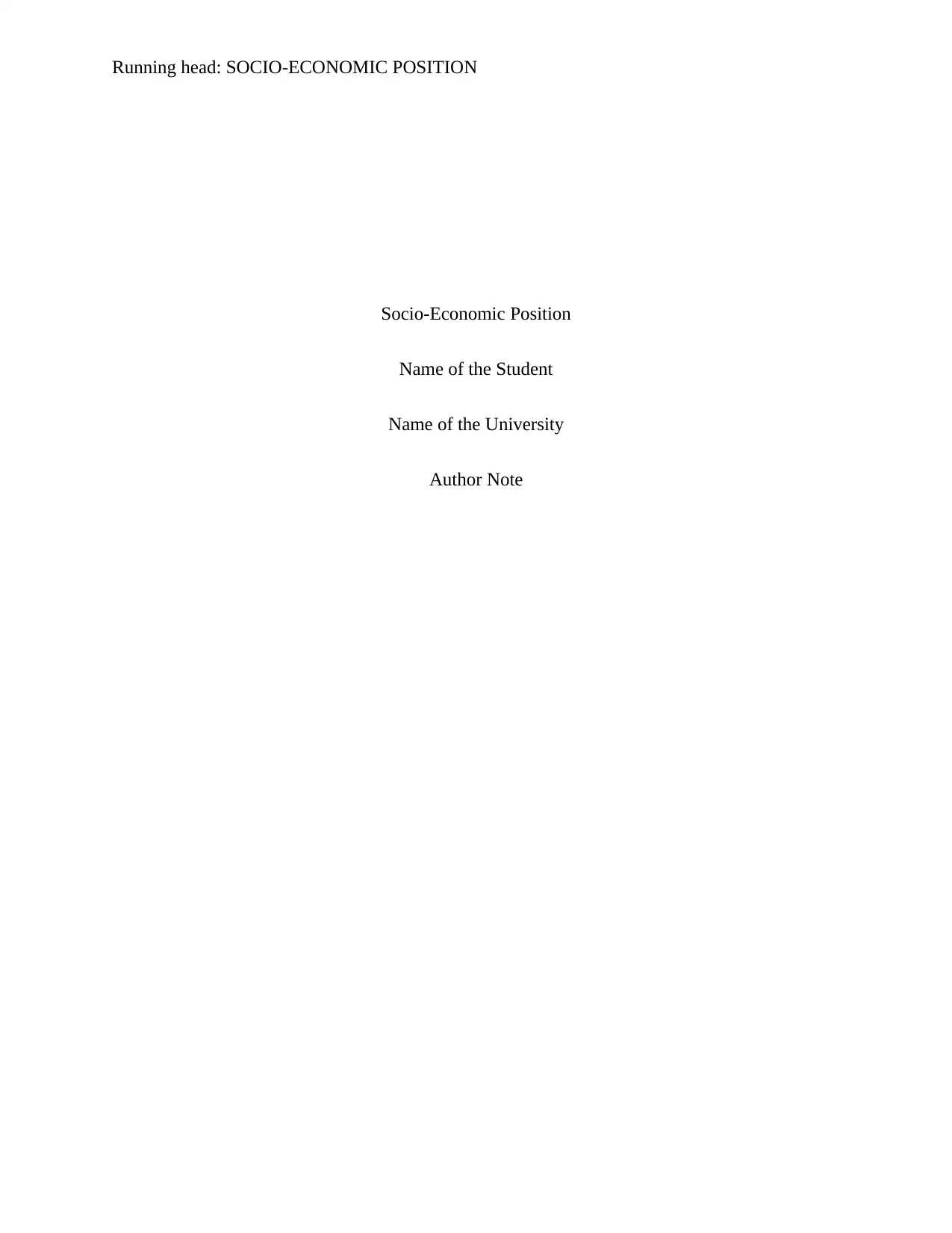
Running head: SOCIO-ECONOMIC POSITION
Socio-Economic Position
Name of the Student
Name of the University
Author Note
Socio-Economic Position
Name of the Student
Name of the University
Author Note
Secure Best Marks with AI Grader
Need help grading? Try our AI Grader for instant feedback on your assignments.
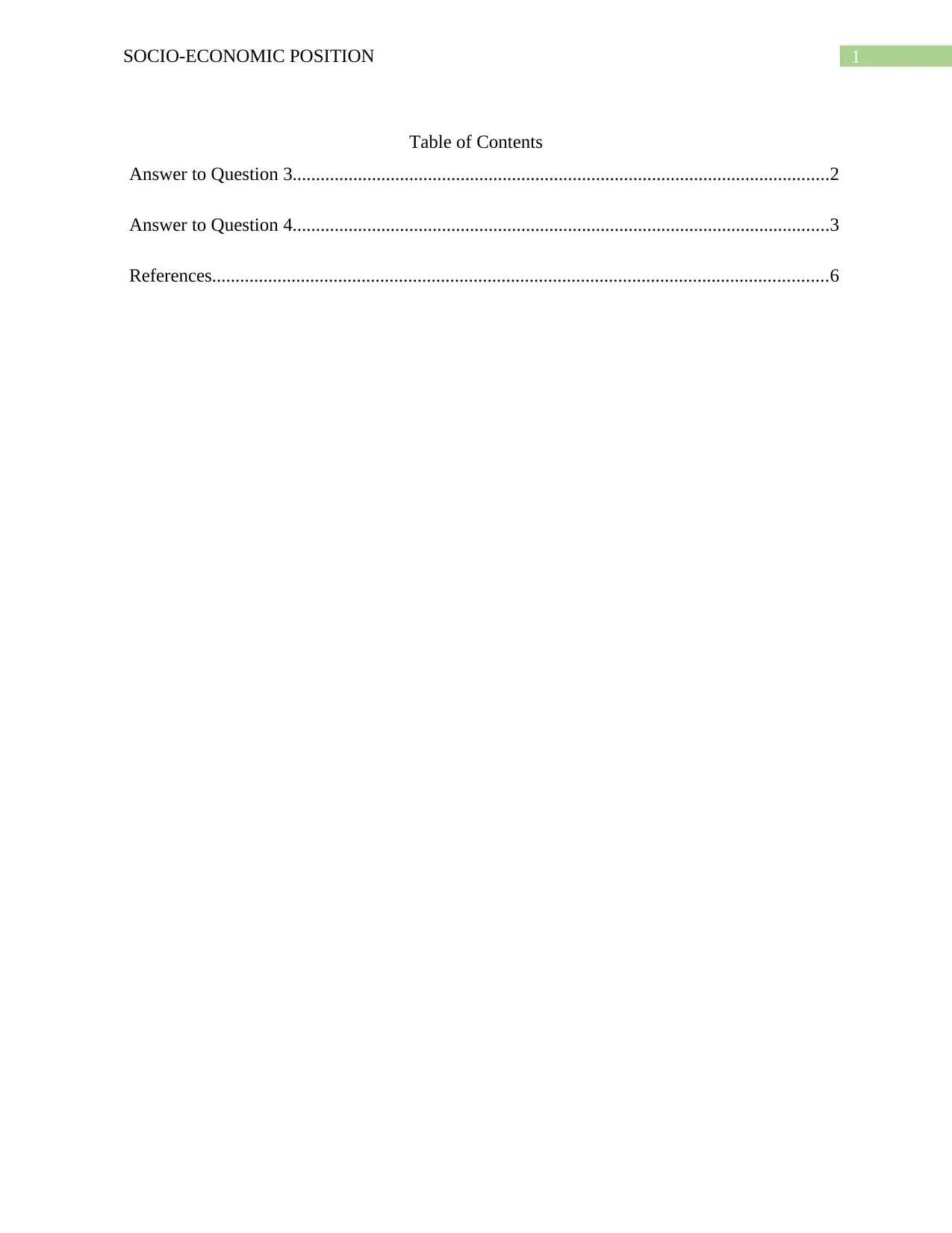
1SOCIO-ECONOMIC POSITION
Table of Contents
Answer to Question 3...................................................................................................................2
Answer to Question 4...................................................................................................................3
References....................................................................................................................................6
Table of Contents
Answer to Question 3...................................................................................................................2
Answer to Question 4...................................................................................................................3
References....................................................................................................................................6
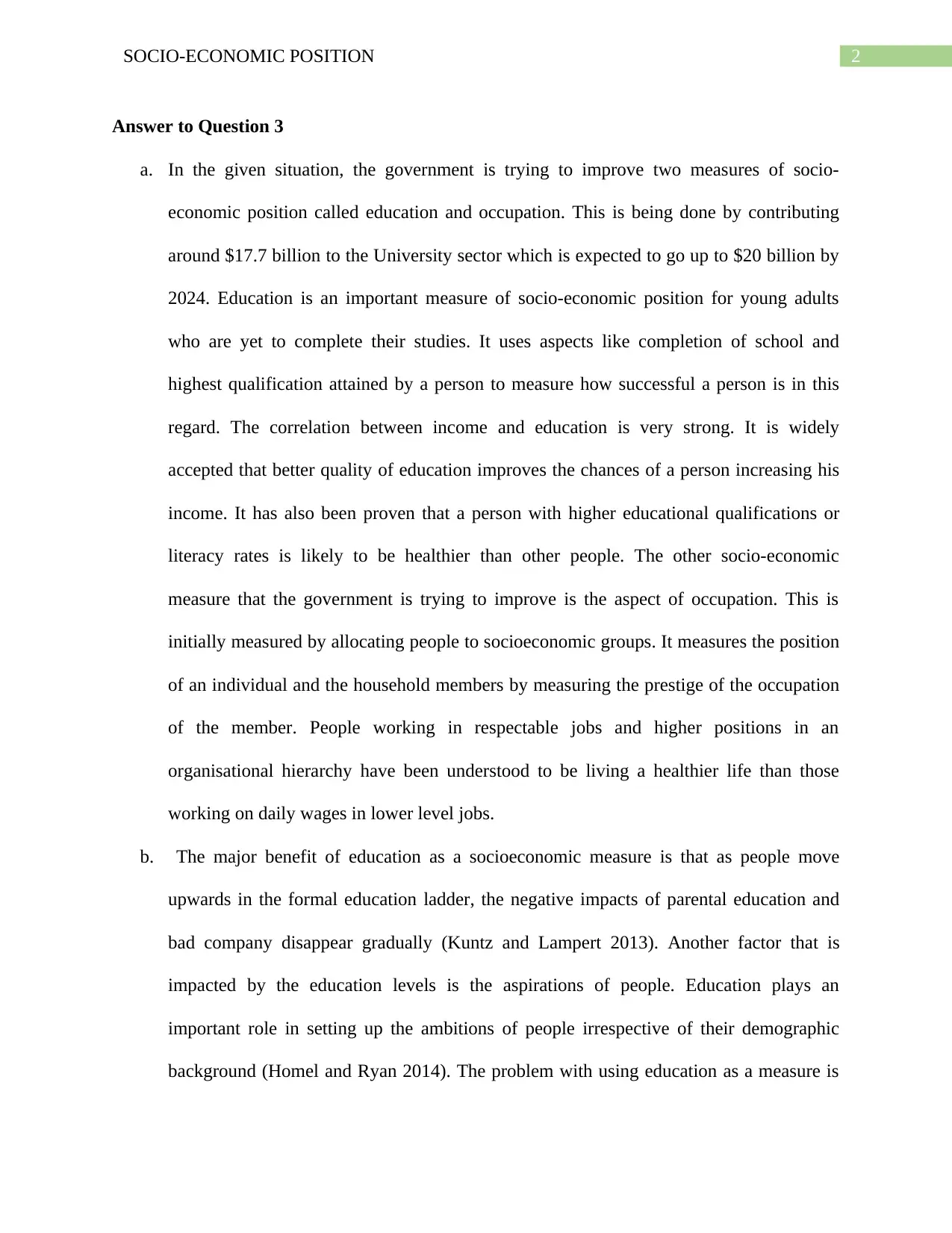
2SOCIO-ECONOMIC POSITION
Answer to Question 3
a. In the given situation, the government is trying to improve two measures of socio-
economic position called education and occupation. This is being done by contributing
around $17.7 billion to the University sector which is expected to go up to $20 billion by
2024. Education is an important measure of socio-economic position for young adults
who are yet to complete their studies. It uses aspects like completion of school and
highest qualification attained by a person to measure how successful a person is in this
regard. The correlation between income and education is very strong. It is widely
accepted that better quality of education improves the chances of a person increasing his
income. It has also been proven that a person with higher educational qualifications or
literacy rates is likely to be healthier than other people. The other socio-economic
measure that the government is trying to improve is the aspect of occupation. This is
initially measured by allocating people to socioeconomic groups. It measures the position
of an individual and the household members by measuring the prestige of the occupation
of the member. People working in respectable jobs and higher positions in an
organisational hierarchy have been understood to be living a healthier life than those
working on daily wages in lower level jobs.
b. The major benefit of education as a socioeconomic measure is that as people move
upwards in the formal education ladder, the negative impacts of parental education and
bad company disappear gradually (Kuntz and Lampert 2013). Another factor that is
impacted by the education levels is the aspirations of people. Education plays an
important role in setting up the ambitions of people irrespective of their demographic
background (Homel and Ryan 2014). The problem with using education as a measure is
Answer to Question 3
a. In the given situation, the government is trying to improve two measures of socio-
economic position called education and occupation. This is being done by contributing
around $17.7 billion to the University sector which is expected to go up to $20 billion by
2024. Education is an important measure of socio-economic position for young adults
who are yet to complete their studies. It uses aspects like completion of school and
highest qualification attained by a person to measure how successful a person is in this
regard. The correlation between income and education is very strong. It is widely
accepted that better quality of education improves the chances of a person increasing his
income. It has also been proven that a person with higher educational qualifications or
literacy rates is likely to be healthier than other people. The other socio-economic
measure that the government is trying to improve is the aspect of occupation. This is
initially measured by allocating people to socioeconomic groups. It measures the position
of an individual and the household members by measuring the prestige of the occupation
of the member. People working in respectable jobs and higher positions in an
organisational hierarchy have been understood to be living a healthier life than those
working on daily wages in lower level jobs.
b. The major benefit of education as a socioeconomic measure is that as people move
upwards in the formal education ladder, the negative impacts of parental education and
bad company disappear gradually (Kuntz and Lampert 2013). Another factor that is
impacted by the education levels is the aspirations of people. Education plays an
important role in setting up the ambitions of people irrespective of their demographic
background (Homel and Ryan 2014). The problem with using education as a measure is
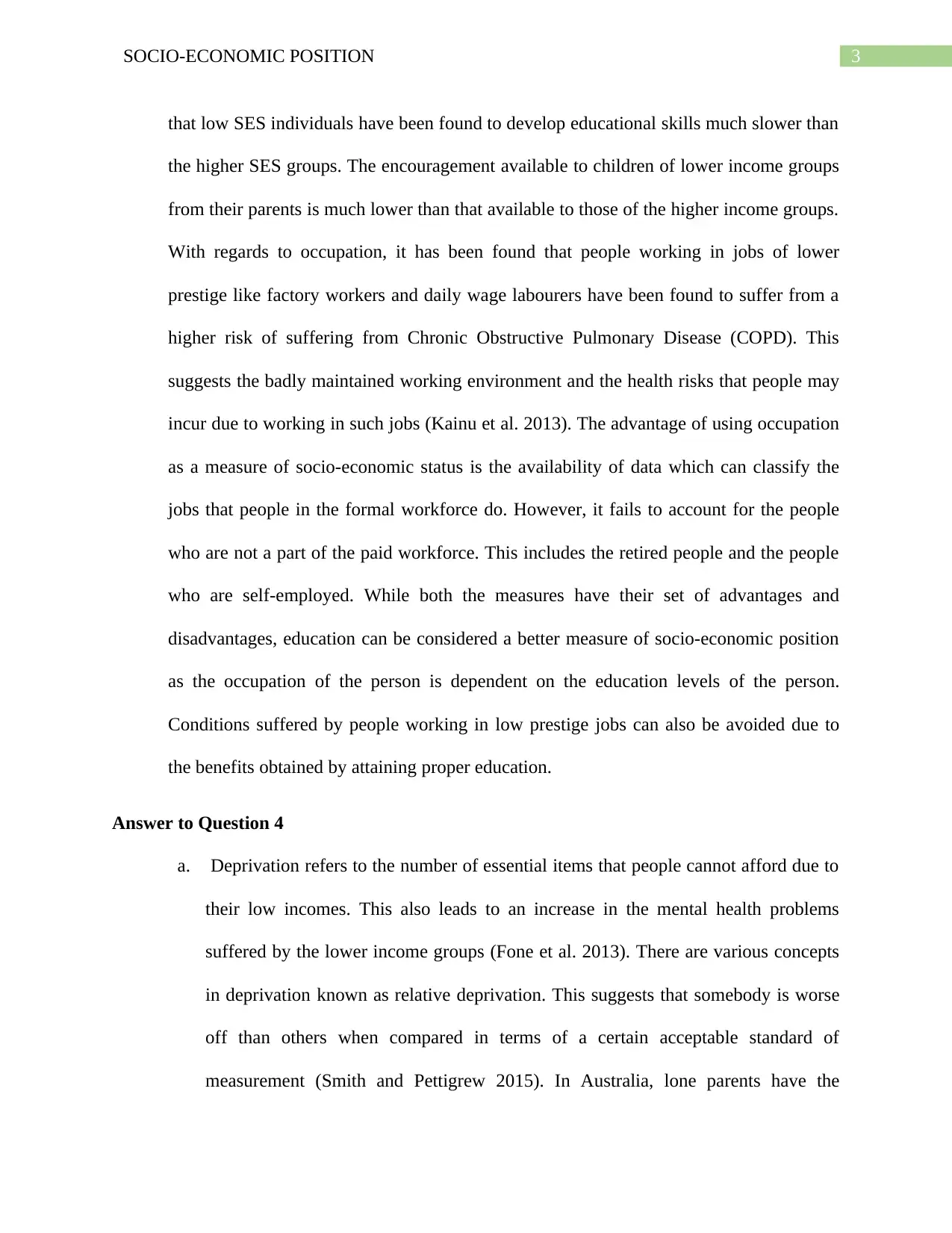
3SOCIO-ECONOMIC POSITION
that low SES individuals have been found to develop educational skills much slower than
the higher SES groups. The encouragement available to children of lower income groups
from their parents is much lower than that available to those of the higher income groups.
With regards to occupation, it has been found that people working in jobs of lower
prestige like factory workers and daily wage labourers have been found to suffer from a
higher risk of suffering from Chronic Obstructive Pulmonary Disease (COPD). This
suggests the badly maintained working environment and the health risks that people may
incur due to working in such jobs (Kainu et al. 2013). The advantage of using occupation
as a measure of socio-economic status is the availability of data which can classify the
jobs that people in the formal workforce do. However, it fails to account for the people
who are not a part of the paid workforce. This includes the retired people and the people
who are self-employed. While both the measures have their set of advantages and
disadvantages, education can be considered a better measure of socio-economic position
as the occupation of the person is dependent on the education levels of the person.
Conditions suffered by people working in low prestige jobs can also be avoided due to
the benefits obtained by attaining proper education.
Answer to Question 4
a. Deprivation refers to the number of essential items that people cannot afford due to
their low incomes. This also leads to an increase in the mental health problems
suffered by the lower income groups (Fone et al. 2013). There are various concepts
in deprivation known as relative deprivation. This suggests that somebody is worse
off than others when compared in terms of a certain acceptable standard of
measurement (Smith and Pettigrew 2015). In Australia, lone parents have the
that low SES individuals have been found to develop educational skills much slower than
the higher SES groups. The encouragement available to children of lower income groups
from their parents is much lower than that available to those of the higher income groups.
With regards to occupation, it has been found that people working in jobs of lower
prestige like factory workers and daily wage labourers have been found to suffer from a
higher risk of suffering from Chronic Obstructive Pulmonary Disease (COPD). This
suggests the badly maintained working environment and the health risks that people may
incur due to working in such jobs (Kainu et al. 2013). The advantage of using occupation
as a measure of socio-economic status is the availability of data which can classify the
jobs that people in the formal workforce do. However, it fails to account for the people
who are not a part of the paid workforce. This includes the retired people and the people
who are self-employed. While both the measures have their set of advantages and
disadvantages, education can be considered a better measure of socio-economic position
as the occupation of the person is dependent on the education levels of the person.
Conditions suffered by people working in low prestige jobs can also be avoided due to
the benefits obtained by attaining proper education.
Answer to Question 4
a. Deprivation refers to the number of essential items that people cannot afford due to
their low incomes. This also leads to an increase in the mental health problems
suffered by the lower income groups (Fone et al. 2013). There are various concepts
in deprivation known as relative deprivation. This suggests that somebody is worse
off than others when compared in terms of a certain acceptable standard of
measurement (Smith and Pettigrew 2015). In Australia, lone parents have the
Secure Best Marks with AI Grader
Need help grading? Try our AI Grader for instant feedback on your assignments.
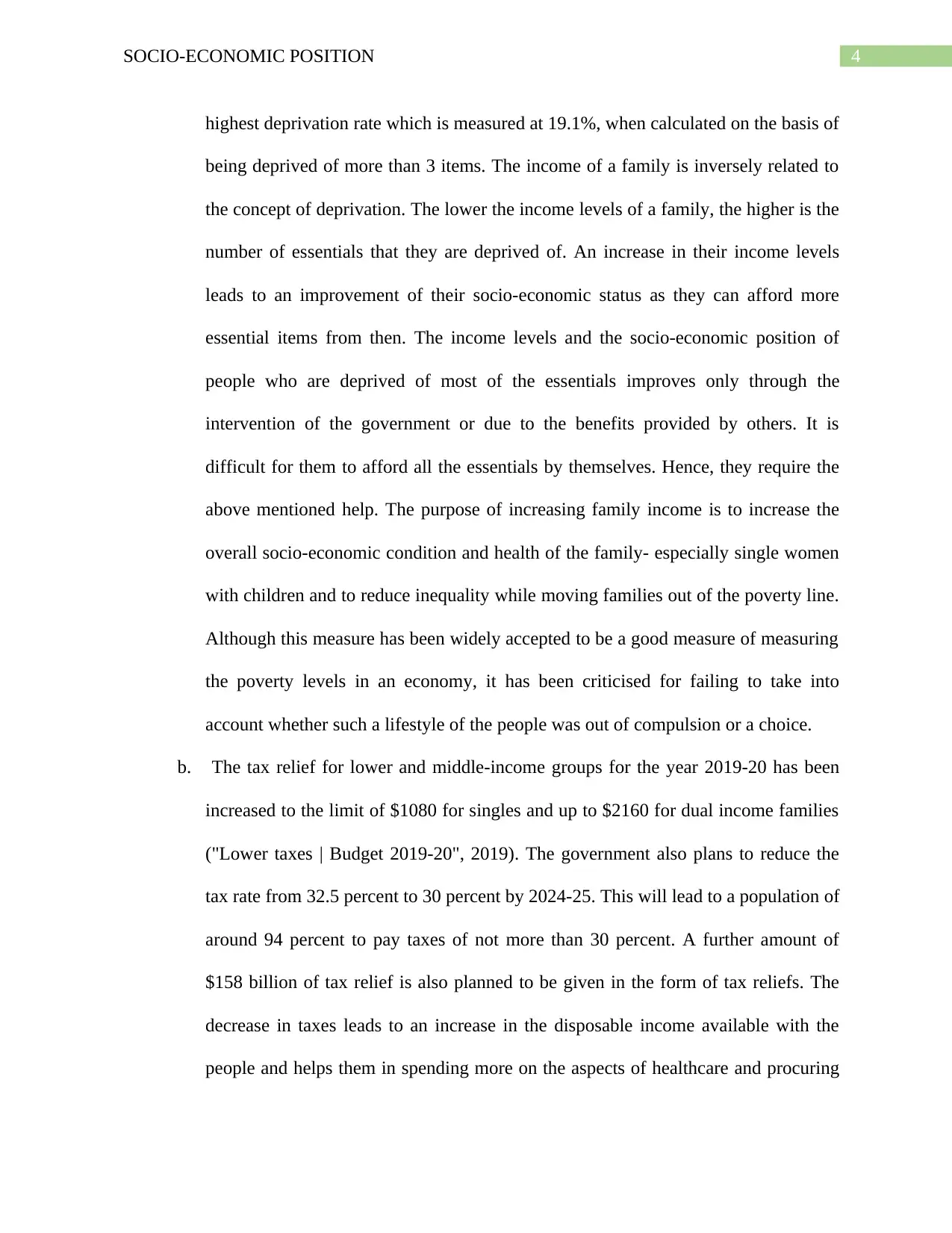
4SOCIO-ECONOMIC POSITION
highest deprivation rate which is measured at 19.1%, when calculated on the basis of
being deprived of more than 3 items. The income of a family is inversely related to
the concept of deprivation. The lower the income levels of a family, the higher is the
number of essentials that they are deprived of. An increase in their income levels
leads to an improvement of their socio-economic status as they can afford more
essential items from then. The income levels and the socio-economic position of
people who are deprived of most of the essentials improves only through the
intervention of the government or due to the benefits provided by others. It is
difficult for them to afford all the essentials by themselves. Hence, they require the
above mentioned help. The purpose of increasing family income is to increase the
overall socio-economic condition and health of the family- especially single women
with children and to reduce inequality while moving families out of the poverty line.
Although this measure has been widely accepted to be a good measure of measuring
the poverty levels in an economy, it has been criticised for failing to take into
account whether such a lifestyle of the people was out of compulsion or a choice.
b. The tax relief for lower and middle-income groups for the year 2019-20 has been
increased to the limit of $1080 for singles and up to $2160 for dual income families
("Lower taxes | Budget 2019-20", 2019). The government also plans to reduce the
tax rate from 32.5 percent to 30 percent by 2024-25. This will lead to a population of
around 94 percent to pay taxes of not more than 30 percent. A further amount of
$158 billion of tax relief is also planned to be given in the form of tax reliefs. The
decrease in taxes leads to an increase in the disposable income available with the
people and helps them in spending more on the aspects of healthcare and procuring
highest deprivation rate which is measured at 19.1%, when calculated on the basis of
being deprived of more than 3 items. The income of a family is inversely related to
the concept of deprivation. The lower the income levels of a family, the higher is the
number of essentials that they are deprived of. An increase in their income levels
leads to an improvement of their socio-economic status as they can afford more
essential items from then. The income levels and the socio-economic position of
people who are deprived of most of the essentials improves only through the
intervention of the government or due to the benefits provided by others. It is
difficult for them to afford all the essentials by themselves. Hence, they require the
above mentioned help. The purpose of increasing family income is to increase the
overall socio-economic condition and health of the family- especially single women
with children and to reduce inequality while moving families out of the poverty line.
Although this measure has been widely accepted to be a good measure of measuring
the poverty levels in an economy, it has been criticised for failing to take into
account whether such a lifestyle of the people was out of compulsion or a choice.
b. The tax relief for lower and middle-income groups for the year 2019-20 has been
increased to the limit of $1080 for singles and up to $2160 for dual income families
("Lower taxes | Budget 2019-20", 2019). The government also plans to reduce the
tax rate from 32.5 percent to 30 percent by 2024-25. This will lead to a population of
around 94 percent to pay taxes of not more than 30 percent. A further amount of
$158 billion of tax relief is also planned to be given in the form of tax reliefs. The
decrease in taxes leads to an increase in the disposable income available with the
people and helps them in spending more on the aspects of healthcare and procuring
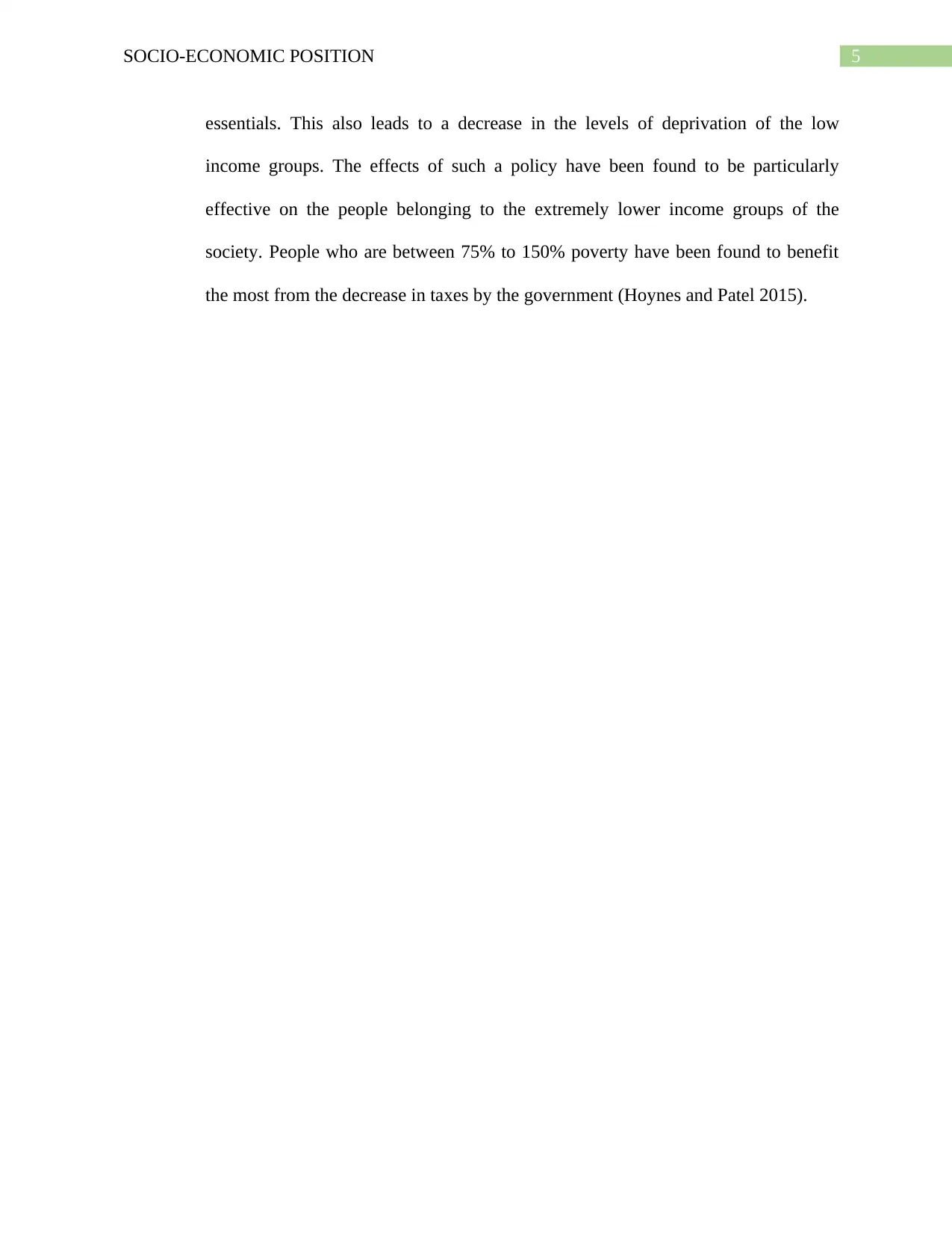
5SOCIO-ECONOMIC POSITION
essentials. This also leads to a decrease in the levels of deprivation of the low
income groups. The effects of such a policy have been found to be particularly
effective on the people belonging to the extremely lower income groups of the
society. People who are between 75% to 150% poverty have been found to benefit
the most from the decrease in taxes by the government (Hoynes and Patel 2015).
essentials. This also leads to a decrease in the levels of deprivation of the low
income groups. The effects of such a policy have been found to be particularly
effective on the people belonging to the extremely lower income groups of the
society. People who are between 75% to 150% poverty have been found to benefit
the most from the decrease in taxes by the government (Hoynes and Patel 2015).
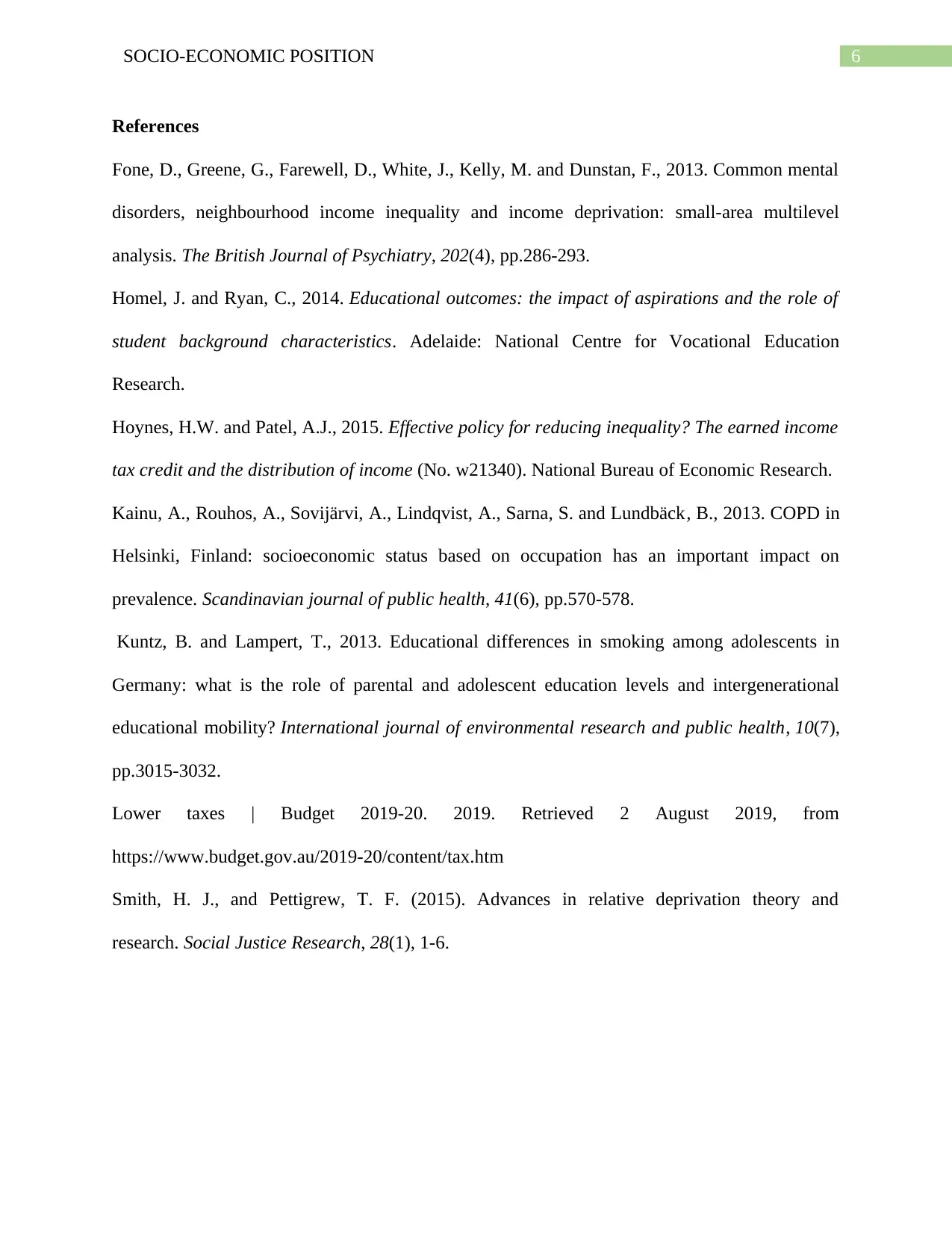
6SOCIO-ECONOMIC POSITION
References
Fone, D., Greene, G., Farewell, D., White, J., Kelly, M. and Dunstan, F., 2013. Common mental
disorders, neighbourhood income inequality and income deprivation: small-area multilevel
analysis. The British Journal of Psychiatry, 202(4), pp.286-293.
Homel, J. and Ryan, C., 2014. Educational outcomes: the impact of aspirations and the role of
student background characteristics. Adelaide: National Centre for Vocational Education
Research.
Hoynes, H.W. and Patel, A.J., 2015. Effective policy for reducing inequality? The earned income
tax credit and the distribution of income (No. w21340). National Bureau of Economic Research.
Kainu, A., Rouhos, A., Sovijärvi, A., Lindqvist, A., Sarna, S. and Lundbäck, B., 2013. COPD in
Helsinki, Finland: socioeconomic status based on occupation has an important impact on
prevalence. Scandinavian journal of public health, 41(6), pp.570-578.
Kuntz, B. and Lampert, T., 2013. Educational differences in smoking among adolescents in
Germany: what is the role of parental and adolescent education levels and intergenerational
educational mobility? International journal of environmental research and public health, 10(7),
pp.3015-3032.
Lower taxes | Budget 2019-20. 2019. Retrieved 2 August 2019, from
https://www.budget.gov.au/2019-20/content/tax.htm
Smith, H. J., and Pettigrew, T. F. (2015). Advances in relative deprivation theory and
research. Social Justice Research, 28(1), 1-6.
References
Fone, D., Greene, G., Farewell, D., White, J., Kelly, M. and Dunstan, F., 2013. Common mental
disorders, neighbourhood income inequality and income deprivation: small-area multilevel
analysis. The British Journal of Psychiatry, 202(4), pp.286-293.
Homel, J. and Ryan, C., 2014. Educational outcomes: the impact of aspirations and the role of
student background characteristics. Adelaide: National Centre for Vocational Education
Research.
Hoynes, H.W. and Patel, A.J., 2015. Effective policy for reducing inequality? The earned income
tax credit and the distribution of income (No. w21340). National Bureau of Economic Research.
Kainu, A., Rouhos, A., Sovijärvi, A., Lindqvist, A., Sarna, S. and Lundbäck, B., 2013. COPD in
Helsinki, Finland: socioeconomic status based on occupation has an important impact on
prevalence. Scandinavian journal of public health, 41(6), pp.570-578.
Kuntz, B. and Lampert, T., 2013. Educational differences in smoking among adolescents in
Germany: what is the role of parental and adolescent education levels and intergenerational
educational mobility? International journal of environmental research and public health, 10(7),
pp.3015-3032.
Lower taxes | Budget 2019-20. 2019. Retrieved 2 August 2019, from
https://www.budget.gov.au/2019-20/content/tax.htm
Smith, H. J., and Pettigrew, T. F. (2015). Advances in relative deprivation theory and
research. Social Justice Research, 28(1), 1-6.
1 out of 7
Related Documents
Your All-in-One AI-Powered Toolkit for Academic Success.
+13062052269
info@desklib.com
Available 24*7 on WhatsApp / Email
![[object Object]](/_next/static/media/star-bottom.7253800d.svg)
Unlock your academic potential
© 2024 | Zucol Services PVT LTD | All rights reserved.





